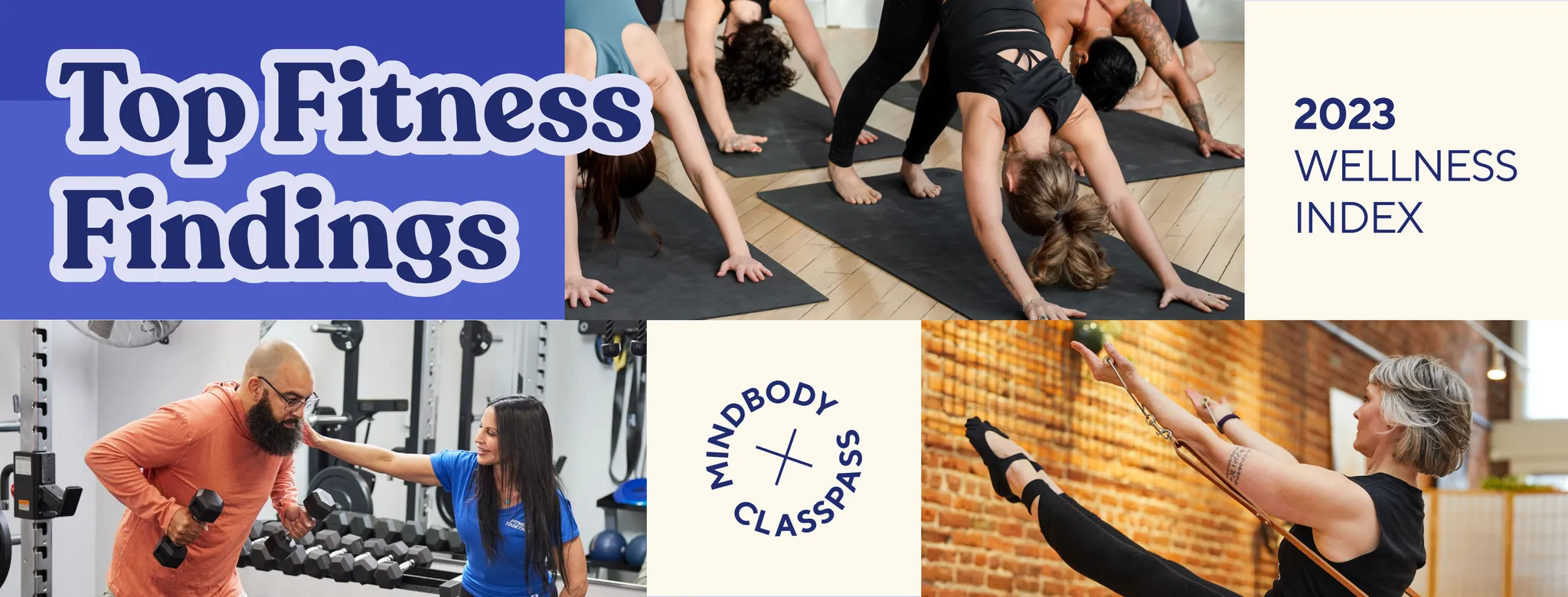
Fitness-focused Findings for 2023
Last updated: June 23, 2025
As part of this year's Wellness Index, we surveyed more than 17,000 Americans to better understand the role fitness plays in their lives. We asked about their motivations for movement, favorite workouts, recovery techniques, and more.
With so much to share, let's jump right in. Here's what we know about the current state of fitness.
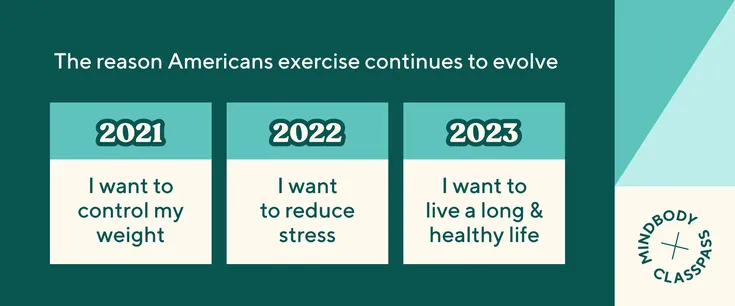
More than a workout: Fitness is key to a long and content life
The benefits of movement aren't just physical. Those who exercise regularly report feeling less stressed and happier as well as more spiritually fulfilled, joyful in their work, connected to their community—the list goes on. Nearly 40% of consumers say they use physical activity to help support their mental well-being, too.
As a result, the motivation for fitness continues to evolve. Pre-pandemic, Americans exercised to control their weight. Last year, it was to reduce stress. Today, longevity is the focus. Nearly one third of consumers say they exercise to lead long and healthy lives—a significant bump from last year.
With increasingly meaningful motivators, it comes as no surprise that 3 out of 4 consumers think wellness is more important than ever and nearly 65% say wellness is more important than other leisure expenses.1 Bottom line: Fitness isn't a nice-to-have; it's a mainstay.
What that means for fitness businesses: Studios and gyms should incorporate deeper motivations into their messaging. Those that continue to reiterate the benefits of movement for a long, healthy, and well-rounded life will likely have more staying power with consumers. It's so much more than a workout, after all. An educational email campaign—with the help of Marketing Suite, of course—is the perfect place to start.
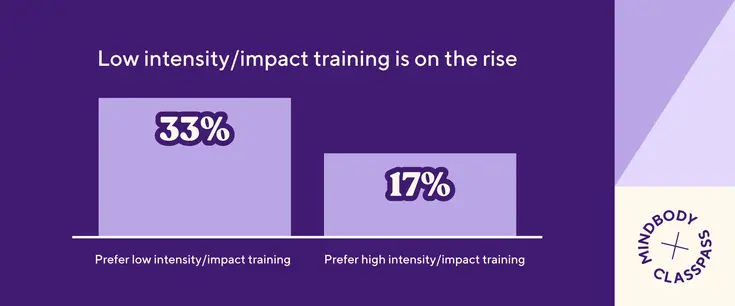
The low down on longevity: Low-impact movement and recovery are in
While boxing is the most popular in-person fitness class, consumers also want workouts that pack less of a punch. In fact, the average American fitness routine breaks down to be 40% low intensity training, 25% moderate intensity training, 17% high intensity training, and 19% recovery.
More than one third of Americans say they prefer low intensity/impact training exclusively. Those who do credit the relaxing benefits and ability to work on strength and endurance without the risk of getting injured as the top reasons why.
Recovery also continues to be a priority for consumers. Nearly half of Americans say stretching and restorative yoga are very important to them and more than a quarter of Americans "biohack" to optimize their physical performance. Another way Americans seek to improve performance, reduce inflammation, and alleviate soreness? Ice baths. More than one third of consumers have tried or are interested in taking the plunge.
What that means for fitness businesses: If they haven't already, gyms and studios should consider adding low-impact offerings as well as ways to promote recovery. This could include mobility and stretching classes, on-demand recovery workouts, or partnerships with local businesses that offer services like cryotherapy, floating, and the like. One of the best ways to get these new offerings in front of consumers? Get listed on ClassPass. With our guarantee, all you have to do is sign up for three months—totally free. If ClassPass doesn't increase your revenue in 90 days, we'll write you a check for double any loss. (Terms apply.)
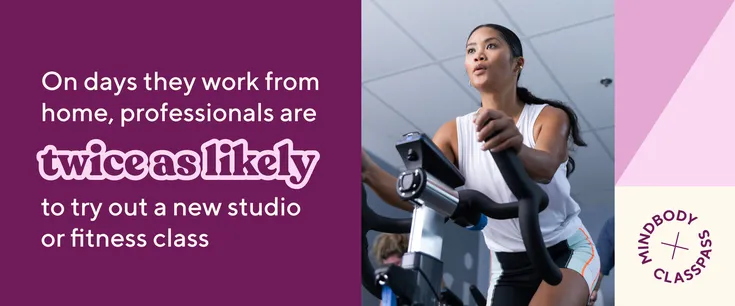
Out of office: Consumers get their fill of water cooler talk at the gym
With so many Americans working from home, the gym has become even more of a weekday destination. On days they WFH, professionals are twice as likely to try out a new studio or fitness class—the perfect break after working out of a home office all day.2 Getting out of the house is also good for motivation. Over 60% of consumers find in-person workouts at a gym or fitness studio motivating to help reach their fitness goals.
Work-from-home life may be why more Americans are looking to the gym for social connection, too. More than a third of consumers are likely to choose wellness businesses that are well known for their community-building activities and nearly a quarter say they're more focused on wellness to feel connected to others.
What that means for fitness businesses: If community was important for fitness businesses before, it's absolutely critical now. Fitness studios and gyms should facilitate opportunities for connection both inside and outside their facilities. This might look like monthly social events, partner-based challenges, or even designated spaces for members to congregate before and after their workouts.
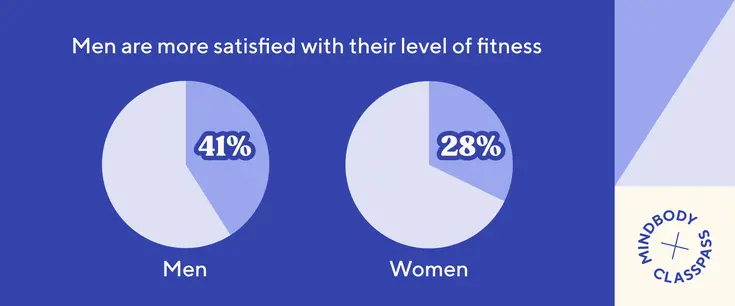
The gender divide: Men still put fitness first
Men not only exercise longer (46 minutes versus 38 minutes) and more frequently than women (2.7 times per week versus 2.5 times per week), but also frequent gyms and fitness studios and work out with personal trainers more often. As a result, men are more satisfied with their overall fitness level—with millennial men being the most satisfied.
That said, women are becoming more intentional with their programming. In fact, 35% of women between 18-50 structure their workouts based on their menstrual cycle, with Gen Z and millennials most likely to do so.
Women, however, still report higher rates of "gymtimidation" than men—although less than last year. Nearly half say that getting in better shape first would help, followed by seeing more diversity in fitness promotions.
What that means for fitness businesses: With women prioritizing fitness less than their male counterparts, all fitness businesses—from high-intensity interval training (HIIT) and Pilates studios to big-box gyms—have an opportunity to expand their service offerings to better serve female consumers. From female-centric workshops and mommy-and-me classes to more realistic promotional materials (bye, overly-Photoshopped stock photos), fitness businesses can help women feel more excited about fitness. And if studios aren't capitalizing on getting men into their facilities, now's a good time to start.
With these takeaways in mind, we have no doubt the year ahead will be yet another exciting one for fitness. We're excited to see what's in store—are you?
1. Mindbody Consumer Wellness & Attitudes Survey, 2022.
2. ClassPass Commuting Report, October 2021.



